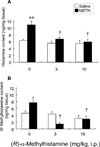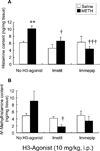Histamine H3 receptor agonists decrease hypothalamic histamine levels and increase stereotypical biting in mice challenged with methamphetamine
- PMID: 21573995
- PMCID: PMC4133108
- DOI: 10.1007/s11064-011-0500-8
Histamine H3 receptor agonists decrease hypothalamic histamine levels and increase stereotypical biting in mice challenged with methamphetamine
Abstract
The effects of the histamine H(3) receptor agonists (R)-α-methylhistamine, imetit and immepip on methamphetamine (METH)-induced stereotypical behavior were examined in mice. The administration of METH (10 mg/kg, i.p.) to male ddY mice induced behaviors including persistent locomotion and stereotypical behaviors, which were classified into four categories: stereotypical head-bobbing (1.9%), circling (1.7%), sniffing (14.3%), and biting (82.1%). Pretreatment with (R)-α-methylhistamine (3 and 10 mg/kg, i.p.) significantly decreased stereotypical sniffing, but increased stereotypical biting induced by METH, in a dose-dependent manner. This effect of (R)-α-methylhistamine on behavior was mimicked by imetit or immepip (brain-penetrating selective histamine H(3) receptor agonists; 10 mg/kg, i.p. for each drug). Hypothalamic histamine levels 1 h after METH challenge were significantly increased in mice pretreated with saline. These increases in histamine levels were significantly decreased by pretreatment with histamine H(3) receptor agonists, effects which would appear to underlie the shift from METH-induced stereotypical sniffing to biting.
Figures






Similar articles
-
Pretreatment with l-histidine produces a shift from methamphetamine-induced stereotypical biting to persistent locomotion in mice.Pharmacol Biochem Behav. 2010 Jan;94(3):464-70. doi: 10.1016/j.pbb.2009.10.009. Epub 2009 Nov 4. Pharmacol Biochem Behav. 2010. PMID: 19895842
-
Sigma1 receptor antagonists determine the behavioral pattern of the methamphetamine-induced stereotypy in mice.Psychopharmacology (Berl). 2009 May;203(4):781-92. doi: 10.1007/s00213-008-1425-z. Epub 2008 Dec 4. Psychopharmacology (Berl). 2009. PMID: 19052726 Free PMC article.
-
Effects of histamine H(3) receptor activation on the behavioral-stimulant effects of methamphetamine and cocaine in mice and squirrel monkeys.Pharmacology. 2009;83(3):164-9. doi: 10.1159/000191473. Epub 2009 Jan 15. Pharmacology. 2009. PMID: 19145102 Free PMC article.
-
Blockade of brain histamine metabolism alters methamphetamine-induced expression pattern of stereotypy in mice via histamine H1 receptors.Neuroscience. 2007 Jul 13;147(3):765-77. doi: 10.1016/j.neuroscience.2007.05.006. Epub 2007 Jun 14. Neuroscience. 2007. PMID: 17570600
-
Are Histamine H3 Antagonists the Definitive Treatment for Acute Methamphetamine Intoxication?Curr Drug Res Rev. 2022;14(3):162-170. doi: 10.2174/2589977514666220414122847. Curr Drug Res Rev. 2022. PMID: 35431009 Review.
Cited by
-
Activation of carbonic anhydrase isoforms involved in modulation of emotional memory and cognitive disorders with histamine agonists, antagonists and derivatives.J Enzyme Inhib Med Chem. 2021 Dec;36(1):719-726. doi: 10.1080/14756366.2021.1891051. J Enzyme Inhib Med Chem. 2021. PMID: 33648390 Free PMC article.
-
Histamine H3 receptor antagonist JNJ-39220675 modulates locomotor responses but not place conditioning by dopaminergic drugs.Psychopharmacology (Berl). 2015 Mar;232(6):1143-53. doi: 10.1007/s00213-014-3751-7. Epub 2014 Oct 12. Psychopharmacology (Berl). 2015. PMID: 25308376
-
Brain Histamine N-Methyltransferase As a Possible Target of Treatment for Methamphetamine Overdose.Drug Target Insights. 2016 Mar 2;10:1-7. doi: 10.4137/DTI.S38342. eCollection 2016. Drug Target Insights. 2016. PMID: 26966348 Free PMC article. Review.
-
Molecular Landscape of Tourette's Disorder.Int J Mol Sci. 2023 Jan 11;24(2):1428. doi: 10.3390/ijms24021428. Int J Mol Sci. 2023. PMID: 36674940 Free PMC article.
References
-
- Ellinwood EH, Kilbey MM. Chronic stimulant intoxication models of psychosis. In: Hanin I, Usdin E, editors. Animal models in Psychiatry and Neurology. New York: Pergamon Press; 1977. pp. 61–74.
-
- Nishikawa T, Mataga N, Takashima M, Toru M. Behavioral sensitization and relative hyperresponsiveness of striatal and limbic dopaminergic neurons after repeated methamphetamine treatment. Eur J Pharmacol. 1983;88:195–203. - PubMed
-
- Robinson TE, Becker JB. Enduring changes in brain and behavior produced by chronic amphetamine administration: a review and evaluation of animal models of amphetamine psychosis. Brain Res Rev. 1986;11:157–198. - PubMed
-
- Randrup A, Munkvad I. Stereotyped activities produced by amphetamine in several animal species and man. Psychopharmacologia (Berl) 1967;11:300–310. - PubMed
-
- Snyder SH. Catecholamines in the brain as mediators of amphetamine psychosis. Arch Gen Psychiatry. 1972;27:169–179. - PubMed
Publication types
MeSH terms
Substances
Grants and funding
LinkOut - more resources
Full Text Sources
Medical

